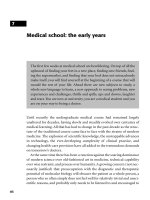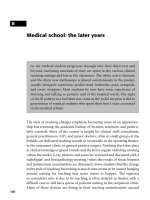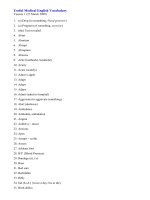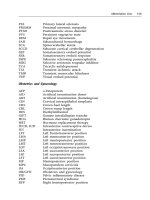MEDICAL PARASITOLOGY
Bạn đang xem bản rút gọn của tài liệu. Xem và tải ngay bản đầy đủ của tài liệu tại đây (851.06 KB, 33 trang )
MEDICAL
PARASITOLOGY
Samar N. El-Beshbishi
Professor of Medical Parasitology
Mansoura Faculty of Medicine
Introduction
Objectives
1.Types of parasites.
2.Types of hosts.
3. Host- parasite relationship.
4. Pathogenesis of parasitic diseases.
5. Zoonosis.
6. Classification of Medical Parasitology.
7. General characters of parasites.
Definitions
• Medical Parasitology: is the study of parasites
of man and their medical consequences.
• Parasites: are organisms which live on or
within its host (infestation & infection) , for
nourishment and physical protection.
• Host: is an organism harbouring a parasite.
Types of parasites
1. Ectoparasite: lives on the surface or within
the superficial tissue of the host (e.g.
Pediculus, mites).
2. Endoparasite: lives within the host, (e.g.
Hookworms).
3. Temporary or intermittent parasite: visits
the host from time to time for food (e.g. soft
ticks).
4. Permanent or obligate parasite: depends
completely upon its host for its entire life (e.g.
Plasmodium, Enterobius).
5. Accidental parasites: free living organisms
which enter the human body by mistake (e.g.
larvae of house flies).
6. Facultative parasite: can exist in a free living or
parasitic state under unfavorable environmental
conditions (e.g. Strongyloides).
7. Specific parasite: affects only one species of
host (e.g. Enterobius).
8. Coprozoic or spurious parasites: foreign
parasites or stages of non human parasites
which have been swallowed and pass to feces
without causing infection (e.g. Fasciola).
Types of hosts
1. Definitive host (D.H.): harbors the adult stage
or sexually mature forms of the parasite e.g. man
for Taenia saginata.
2. Intermediate host (I.H.): harbors the larval
stages or asexually mature forms of the parasite
e.g. man for Plasmodium.
3. Reservoir host (R.H.): carries the adult stage
of parasite, and acts as a continuous source for
human infection e.g. cats for Heterophyes.
4. Amplifier host: is an I.H. in which asexual
multiplication takes place (e.g. snail ist I.H.).
5. Paratenic host (transport host): in which the
parasite doesn't undergo any multiplication or
developmental changes (e.g. fish 2nd I.H.).
6. Vector: is an arthropod which transmits the
parasites from one host to another (e.g. fleas
transmit Pasteurella from rodents to man).
Host-parasite relationship
• Symbiosis: more or less permanent association
of two organisms of different species.
This relationship occurs in 4 forms:
a. Parasitism: one of the two organisms benefits,
on the expense of the other, that suffers from
such association (Schistosoma).
b. Commensalism: the parasite benefits without
harming the host (non-pathogenic ameoba).
c. Mutualism: the relationship is beneficial to
both associates (flagellates in the intestine of
ants that feed on wood).
d. Phoresis: in which the phoront is usually the
smaller organism and is mechanically
transmitted by the other which is usually large
(e.g. Dientameoba fragils on Entrobius egg).
Pathogenesis of parasitic infection
a)Pathogenic
parasite:
causes
pathological lesions (Ancylostoma).
definite
b)Non-pathogenic
(commensal)
parasite:
derives food and protection from host without
causing pathological lesions (Entamoeba coli).
c) Opportunistic parasite: causes mild disease in
immunologically healthy individuals, and
severe pathological lesions in immunodeficient hosts (Cryptosporidium).
Zoonosis
Diseases and infections in which the causative
agents are transmitted from animals to man.
Anthroponosis: parasitic infection is found in
man alone as in trichomoniasis and entrobiasis.
Zooanthroponosis: parasitic infections mainly
affect man and animals become infected in life
cycle of parasite as in taeniasis.
Anthropozoonosis: parasitic infection is mainly
in animal and may be acquired by man as in
trichinosis.
Classification of zoonotic diseases:
1) According to the source of infection:
A-Feral or sylvatic zoonosis: source of infection
is a wild animal. Humans become infected
when population move to infected area or
become exposed during hunting as in
African trypanosomiasis.
B-Domestic
zoonosis:
these
transmitted from man own
animals as in hydatidosis.
parasites
domestic
2) According to the method of transmission:
A-Direct zoonosis: infection is directly
transmitted from the vertebrate R.H. to man
as in trichinosis.
B-Saprozoonosis: infection is transmitted via a
non developmental site as soil and water as
in visceral larva migrans (VLM) and Fasciola.
C-Metazoonosis: infection is transmitted from
the animal R.H. to man via an arthropod as in
leishmaniasis and trypanosomiasis.
Classification of Medical Parasitology
I. Helminthology (helminths):
1- Platyhelminths (flat worms)
- Class: Trematoda (Flat Worms or Flukes).
- Class: Cestoda (Tape worms).
2- Nemathelminths (round worms)
- Class: Nematoda (Round worms).
II. Protozology (protozoa).
III. Arthropods.
General characters of parasites
1. Trematodes: Un-segmented, leaf-shaped, and
hermaphrodite (except schistosomes), e.g.
Fasciola.
2. Cestodes: Long, segmented, tape-like and
hermaphrodite, e.g. Taenia saginata.
3. Nematodes: Elongated, cylindrical with
pointed ends and unisexual, e.g. Ascaris.
4. Protozoa: Unicellular microscopic parasites,
e.g. Giardia intestinalis..
Trematode
Protozoa
Cestode
Insect
Nematode
Medical Helminthology
Platyhelminthes (flat worms)
Class : Trematoda (Flukes)
General characters:
1) Adults are leaf like, pear shaped or elongated
worms, flattened dorsoventrally.
2) Bilaterally symmetrical except schistosomes.
3) Size: varies, some are large fleshy (Fasciola)
others are just visible by naked eye
(Heterophyes).
4) Covered with protective cuticle that may be
smooth, spiny or tuberculated.
5) No body cavity, all organs are embedded in
loose connective tissue cells.
6)
Suckers: for attachment, usually 2 in
number, in some there are 3
(Heterophyes heterophyes).









